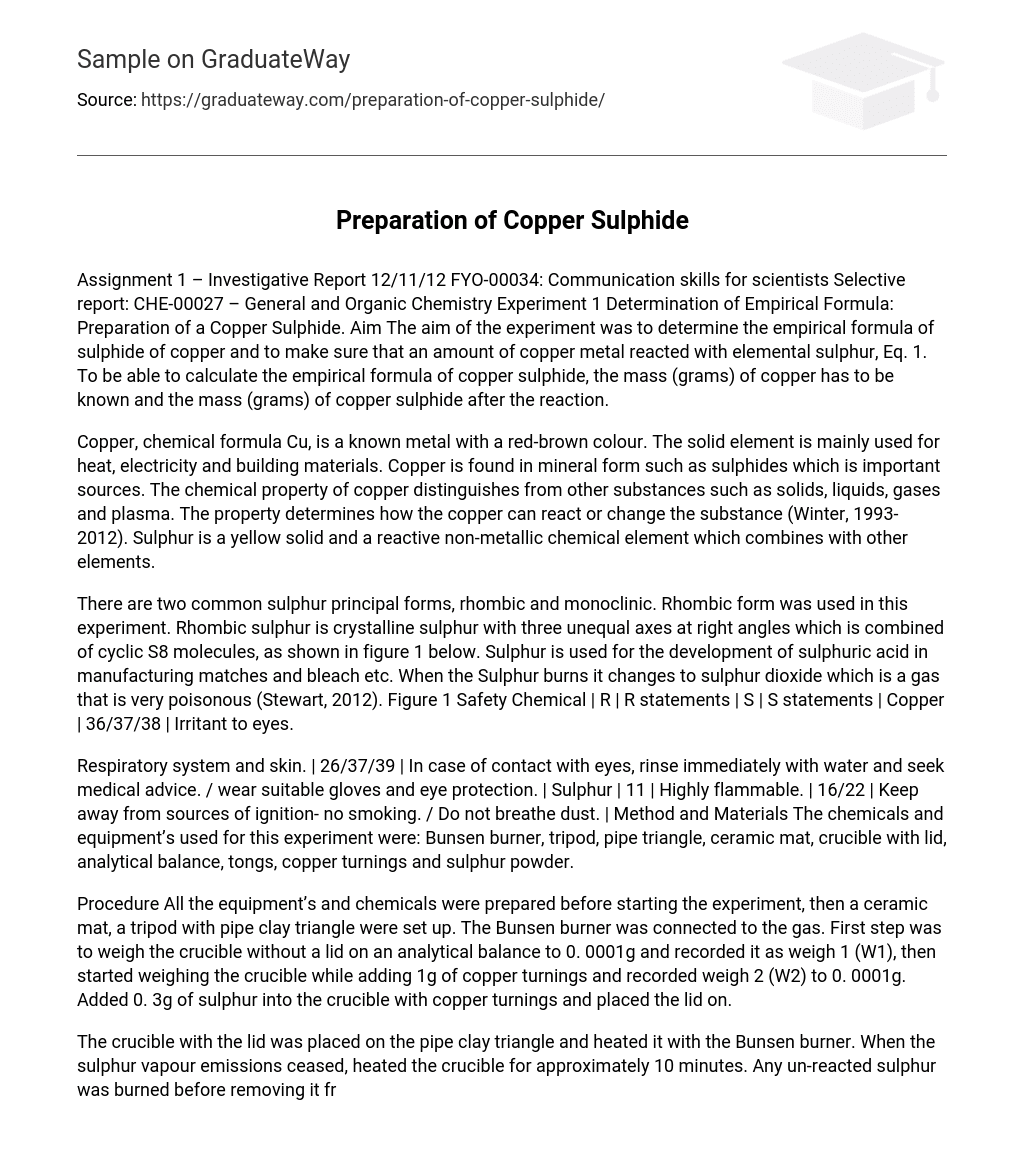Aim
The aim of the experiment was to determine the empirical formula of sulphide of copper and to make sure that an amount of copper metal reacted with elemental sulphur. To be able to calculate the empirical formula of copper sulphide, the mass (grams) of copper has to be known and the mass (grams) of copper sulphide after the reaction.
Copper, chemical formula Cu, is a known metal with a red-brown colour. The solid element is mainly used for heat, electricity and building materials. Copper is found in mineral form such as sulphides which is important sources. The chemical property of copper distinguishes from other substances such as solids, liquids, gases and plasma. The property determines how the copper can react or change the substance (Winter, 1993-2012). Sulphur is a yellow solid and a reactive non-metallic chemical element which combines with other elements.
There are two common sulphur principal forms, rhombic and monoclinic. Rhombic form was used in this experiment. Rhombic sulphur is crystalline sulphur with three unequal axes at right angles which is combined of cyclic S8 molecules, as shown in figure 1 below. Sulphur is used for the development of sulphuric acid in manufacturing matches and bleach etc. When the Sulphur burns it changes to sulphur dioxide which is a gas that is very poisonous (Stewart, 2012).
Procedure
All the equipment’s and chemicals were prepared before starting the experiment, then a ceramic mat, a tripod with pipe clay triangle were set up. The Bunsen burner was connected to the gas. First step was to weigh the crucible without a lid on an analytical balance to 0. 0001g and recorded it as weigh 1 (W1), then started weighing the crucible while adding 1g of copper turnings and recorded weigh 2 (W2) to 0. 0001g. Added 0. 3g of sulphur into the crucible with copper turnings and placed the lid on.
The crucible with the lid was placed on the pipe clay triangle and heated it with the Bunsen burner. When the sulphur vapour emissions ceased, heated the crucible for approximately 10 minutes. Any un-reacted sulphur was burned before removing it from the Bunsen burner. The crucible was then placed on the ceramic mat and cooled for couple of minutes. After cooling, the crucible was weighed without the lid on the analytical balance. Weigh was recorded. To make sure that the copper had reacted a bit of sulphur was added.
The procedure was then repeated from heating the crucible for 10 minutes. Again when the crucible has cooled, the crucible was weighed without the lid. If the weigh had increased, the procedure had to be repeated by adding more sulphur and heating it again and recording the weigh. The two readings of the weigh should only differed 0. 005g or less. All the weigh measurement and the final weigh (W3) were recorded.
Data Recording Weigh of crucible (W1): 17. 09 g Weigh of crucible + copper turnings(W2): 18. 0998g
Weigh of crucible+ copper sulphide (W3): 18. 41g
The calculation for the empirical formula of copper sulphide produced: W2-W1 =Weight (g) of copper in original sample: 18. 0998-17. 09 = 1. 0098g W3-W2=Weight (g) of sulphur reacted: 18. 41-18. 0998=0. 3102g
Calculation of number of moles in each reactant: Number of moles of copper in sample= 1. 0098g/ 63. 46= 0. 0159mol
Number of moles of sulphur reacted= 0. 3102g/32. 06mol-1= 9. 6756mol
Calculation for Empirical formula of the copper sulphide: 0. 0159/9. 6756= 1. 643
Ratio: 1 Rounded to the nearest whole number = 2:1 Ratio= 1:643 x 2:1
Calculated empirical formula = Cu2S
Discussion/Conclusion
In this experiment there were no errors made since the result of empirical formula for copper sulphide were Cu2S. The results supported the aim for this experiment. There are ways that this experiment could have gone wrong. The most common mistakes that can be made is that the sulphur didn’t react with the copper which can give an inaccurate mass of the compound copper sulphide and inaccurate mass of sulphur which had reacted with the copper. Another error that could be made is adding more sulphur than needed into the crucible.
The sulphur won’t react and it will be attached to the copper. By doing this experiment a determination of empirical formula of copper sulphide was made. The copper was weighed in mass and the copper after reaction with sulphur was weighed in mass. After gathering results, empirical formula could be worked out.
References
- Stewart, D, 2012. (2012). Sulfur Element Facts. Available: http://www. chemicool. com/elements/sulfur. html. Last accessed 09/11/12.
- Winter,M. (1993-2012). Copper: The essentials. Available: http://www. webelements. com/copper/. Last accessed 09/11/12.





